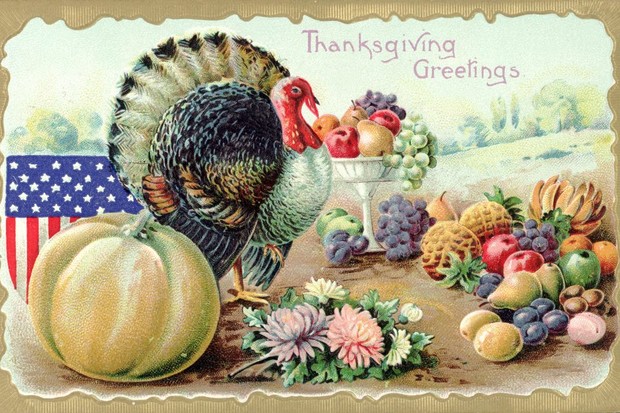Not all Americans celebrate Thanksgiving. Like Columbus Day, it’s a holiday with troubled historical roots. From the Smithsonian, see The Myths of the Thanksgiving Story and the Lasting Damage They Imbue.
On the other hand, for all its past, in the here and now the holiday has come to be a time to celebrate family, togetherness, and appreciation of what we’re lucky enough to have – all indisputably good things and traditions we’d be poorer without. But that doesn’t mean that we shouldn’t know both sides of the Thanksgiving story.
From Learning for Justice, see Teaching Thanksgiving in a Socially Responsible Way for resources and recommendations for Native American historical perspectives.
For more resources, also see Native Americans.
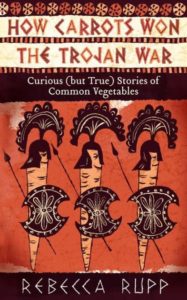 |
How Carrots Won the Trojan War (Storey Publishing, 2011), a catchy science and history of garden vegetables, is packed with stories and information adaptable for a wide range of educational and just plain interesting purposes. For Thanksgiving, check out the corn and pumpkin chapters. Find out what corn has to do with vampires and why pumpkins occasionally explode. |
Table of Contents
HISTORICAL THANKSGIVING
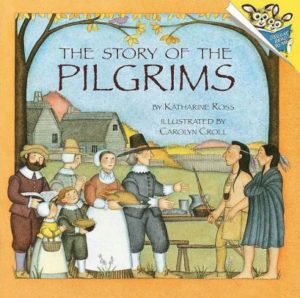 |
Katharine Ross’s The Story of the Pilgrims (Random House, 1995) is a simple and attractively illustrated account of the Thanksgiving story for ages 3-7. (It begins “Once upon a time…”) |
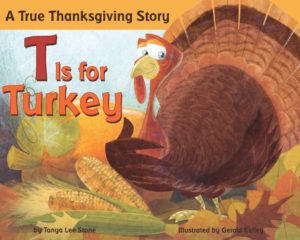 |
Tanya Lee Stone’s T is for Turkey is a rhyming alphabet book, a school play, and the story of the first Thanksgiving all in one – beginning with A for American story, and continuing on through H for Sarah Hale, P for Pilgrim, S for Squanto, and, of course, T for Turkey. For ages 3-7. |
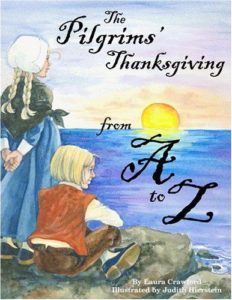 |
By Laura Crawford, The Pilgrims’ Thanksgiving from A to Z (Pelican Publishing, 2005) is an alphabet book of Pilgrim history, in which A is for Atlantic Ocean, H for Hardship, Q for Quahog, N for November, W for Wampanoag. For ages 4-8. |
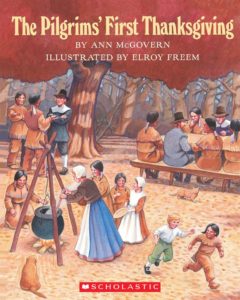 |
Ann McGovern’s The Pilgrims’ First Thanksgiving (Scholastic, 1993) is a short picture-book history filled with interesting details. Readers learn that two dogs and a cat sailed on the Mayflower, that the ship was the size of two trucks, and that the first Thanksgiving feast lasted for three whole days. For ages 4-8. |
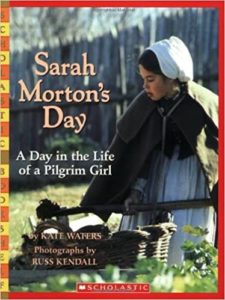 |
By Kate Waters, Sarah Morton’s Day (Scholastic, 2008) – illustrated with wonderful photos from the Plimouth Plantation living museum – is an account of a day in the life of a nine-year-old Pilgrim girl in 1627. For ages 4-8.
In the same format, see Waters’s Samuel Eaton’s Day (Scholastic, 1996), a photo-illustrated day in the life of a seven-year-old Pilgrim boy. |
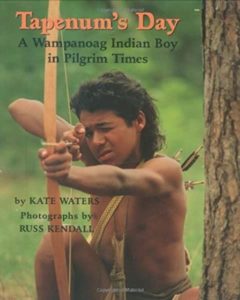 |
Also by Kate Waters, Tapenum’s Day (Scholastic, 1995), a typical day in the life of a young Wampanoag boy in the early 1600s – which begins with young Tapenum disappointed that he has not yet been chosen for initiation at a pniesog, a warrior. For ages 4-8. |
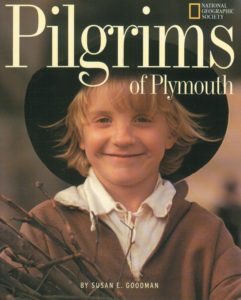 |
Susan E. Goodman’s Pilgrims of Plymouth (National Geographic Children’s Books, 2001) is the story of the everyday lives of Pilgrim children, illustrated with great color photographs from the Plimouth Plantation living history museum. For ages 4-8. |
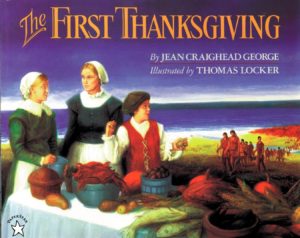 |
Jean Craighead George’s The First Thanksgiving (Puffin, 2001) puts the holiday in a long perspective, starting with the shaping of Cape Cod and deposit of Plymouth Rock by glaciers, then the warming of the climate, the arrival of the Pawtuxets, the kidnapping and return of Squanto, and the coming of the Pilgrims. Illustrated with beautiful paintings by Thomas Locker. For ages 4-8. |
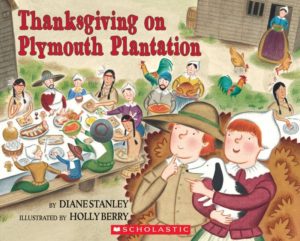 |
In Diane Stanley’s Thanksgiving on Plymouth Plantation (HarperCollins, 2004), Liz and Lenny (the Time-Traveling Twins), along with their grandma and dog, Moose, travel back in time to 1621 and the first Thanksgiving feast. A cleverly presented approach to the real story of Thanksgiving. Illustrated endpapers compare what foods were eaten at the first feast (boiled eels, pottage, beer) to what is traditionally eaten today. For ages 4-8. |
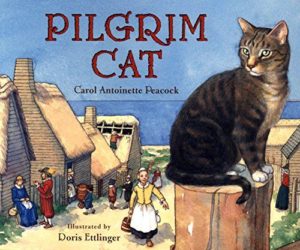 |
In Carol Peacock’s Pilgrim Cat (Albert Whitman & Company, 2004), young Faith adopts a stray cat on board the Mayflower and names it Pounce. The cat remains her friend through all the hardships ahead (and ultimately produces a litter of Pilgrim kittens). For ages 4-8. |
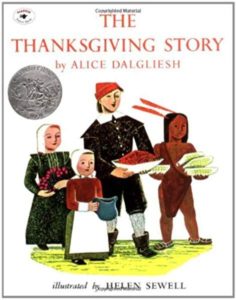 |
By Alice Dalgleish, The Thanksgiving Story (Aladdin, 1985) – with stylized folkart-ish illustrations by Helen Sewell – is the story of the Mayflower voyage, the Plymouth colony, and the first Thanksgiving as seen through the eyes of young Pilgrims Giles, Constance, and Damaris Hopkins. For ages 5-8. |
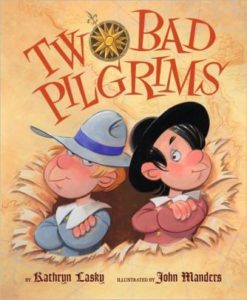 |
Kathryn Lasky’s Two Bad Pilgrims (Viking Juvenile Books, 2009) is the story of obstreperous real-life Pilgrim boys Francis and John Billington, who nearly blew up the Mayflower. For ages 5-8. |
| For more on the badly behaved Billingtons, see Clyde Bulla’s 88-page John Billington: Friend of Squanto (Ty Crowell Company, 1956). It’s out of print, but is available in inexpensive used editions. For ages 7-10. | |
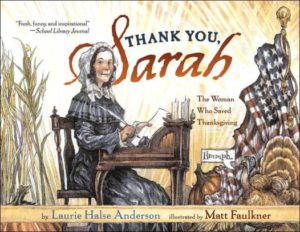 |
By Laurie Halse Anderson, Thank You, Sarah: The Woman Who Saved Thanksgiving (Simon & Schuster, 2005) is a delightful account of Sarah Hale’s 38-year campaign to have Thanksgiving declared a national holiday – which Abraham Lincoln finally signed into law in 1863. The appendix – “A Feast of Facts” – ends by challenging readers to “Pick up a pen. Change the world.” For ages 5-9. |
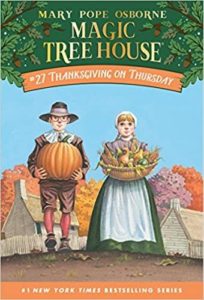 |
In Thanksgiving on Thursday (Random House, 2002), one of Mary Pope Osborne’s Magic Tree House series, the Tree House sends Jack and Annie back in time to 1621, where they meet the Pilgrims and Squanto and almost disrupt the first Thanksgiving. For ages 6-9. |
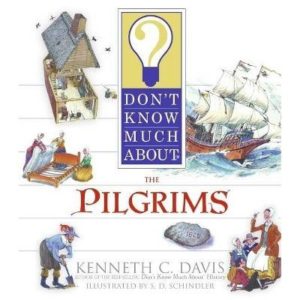 |
Kenneth C. Davis’s appealingly designed Don’t Know Much About the Pilgrims (HarperCollins, 2006) is written is question-and-answer format: “You know they wore tall black hates and ate turkey and cranberries. But who were the Pilgrims, really?” “Did the Pilgrims call themselves Pilgrims?” “What was life like on the Mayflower?” The reader-friendly text is interspersed with cartoonish illustrations, fact boxes, and timelines. For ages 6-9. |
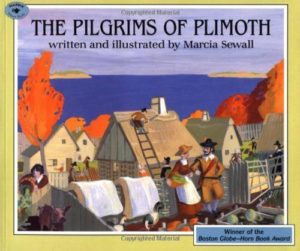 |
Marcia Sewall’s The Pilgrims of Plimoth begins “Aye, Governor Bradford calls us pilgrims. We are English and England was our home.” Illustrated with primitive-style paintings. For ages 6-9. |
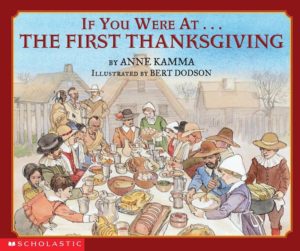 |
Anne Kamma’s If You Were At the First Thanksgiving (Scholastic, 2001) is written in an appealing question-and-answer format that makes for a great interactive reading experience. Questions range from the broadly historical to the everyday: Why did the Pilgrims come to America? Were Pilgrim parents strict? Who was Squanto? Had the Pilgrims seen turkey before they came to America? Did the Pilgrims make cranberry sauce? Did any Indian children come to the first Thanksgiving? For ages 6-10. |
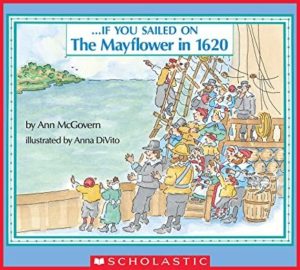 |
Ann McGovern’s If You Sailed on the Mayflower in 1620 (Scholastic, 1991), written in question-and-answer format, features such questions as: How many people sailed on the Mayflower? What could the Pilgrims take with them? Did they land on Plymouth Rock? What did the Pilgrims learn from Squanto? For ages 6-10. |
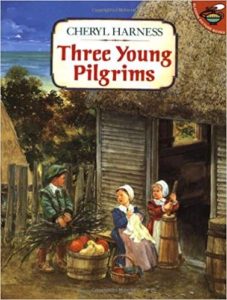 |
Cheryl Harness’s Three Young Pilgrims (Simon & Schuster, 1995) covers a year in the lives of three real children who traveled to America on the Mayflower – Mary, Remember, and Bartholomew Allerton – from the landing of the ship and the establishment of the new Plymouth colony to the first Thanksgiving feast. Well-done history illustrated with terrific paintings and diagrams. For example, there’s a great double-page cutaway spread of the (very crowded) Mayflower, with all the parts of the ship labeled. For ages 6-10. |
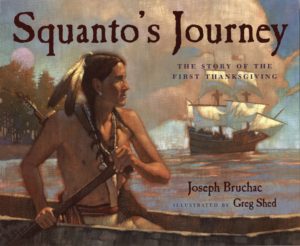 |
By Joseph Bruchac, Squanto’s Journey (Houghton Mifflin Harcourt, 2007), narrated in the first person, is the story of a remarkable life. Squanto was kidnapped by John Smith, sold into slavery in Spain, and eventually made it home again, only to find his family and tribe dead of disease. Nonetheless, he befriended and supported the early settlers at Plymouth. A well-researched story for ages 6-10. |
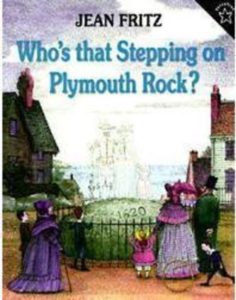 |
Jean Fritz’s Who’s That Stepping on Plymouth Rock? (Puffin, 1998) is a witty and original history of the iconic Plymouth Rock – the one and only big rock on the beach at the time when the Pilgrims (a.k.a. the First Comers) arrived. There’s no evidence that any Pilgrim landed on it, but their descendants built a wharf on top of it, moved it twice, and broke it in half once. A thoroughly interesting read for ages 7-11. (And so is everything else by Jean Fritz.) |
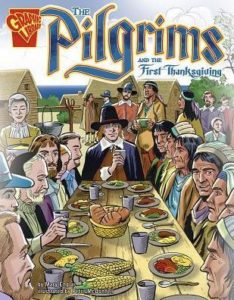 |
Mary Englar’s The Pilgrims and the First Thanksgiving (Capstone Press, 2007) – one of the Graphic History series – is a 32-page comic-book-style account of the Pilgrims’ story. For ages 8 and up. |
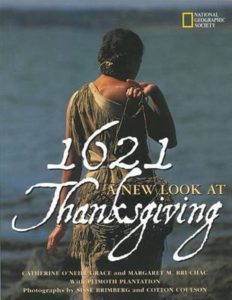 |
Catherine O’Neill Grace’s 1621: A New Look at Thanksgiving (National Geographic Children’s Books, 2004), a Wampanoag-centric look at the famous first feast, has well-researched and fascinating information on the local Pawtuxet tribe and debunks the common mythology of Thanksgiving. An excellent view of history from a Native American viewpoint, illustrated with photos from the Plimouth Plantation living history museum. For ages 8-12. |
| Mayflower Myths is an explanation of common misconceptions about the Pilgrims and the celebration of Thanksgiving. | |
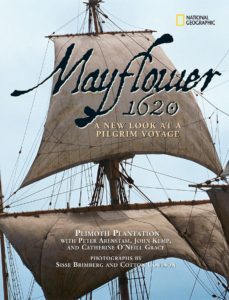 |
By Plimouth Plantation (with Peter Arenstam, John Kemp, and Catherine O’Neill Grace), Mayflower 1620: A New Look at a Pilgrim Voyage (National Geographic Children’s Books, 2007) is a well-researched account of the landmark voyage using primary sources and peppered with first-person accounts. Illustrated with photos from a re-enactment using the Mayflower II. For ages 8-12. |
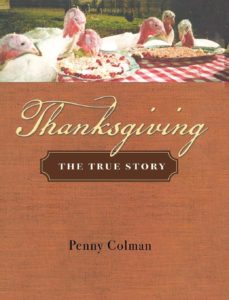 |
Penny Coleman’s 160-page Thanksgiving: The True Story (Henry Holt and Company, 2008) is divided into two main parts – Thanksgiving Origins and Thanksgiving Traditions – both crammed with period illustrations, maps, and fascinating information. (A table lists 12 competing claims for America’s “first Thanksgiving,” variously from Texas, Florida, Maine, and Virginia, as well as Massachusetts.) For ages 10 and up. |
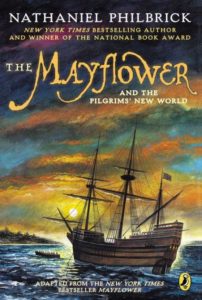 |
Nathaniel Philbrick’s 350-page The Mayflower and the Pilgrims’ New World (Puffin, 2009), adapted and abridged from Philbrick’s best-selling adult book Mayflower (Penguin, 2007), is a detailed and fascinating account spanning the period from the Mayflower voyage to the outbreak of King Philip’s War. Readers learn the true story of the relationship between the Plymouth colonists and the Native Americans, which isn’t that of the traditional Thanksgiving myth. The book is illustrated with maps, photos, and period prints. Included are a timeline, the Mayflower passenger list, additional reading suggestions, and discussion questions. For ages 11 and up. |
| Mark Twain’s Plymouth Rock and the Pilgrims – originally a speech given in 1881 – is a less-than-reverent take on the Pilgrims. (“I have kept still for years; but really I think there is no justification for this sort of thing. What do you want to celebrate those people for?”) | |
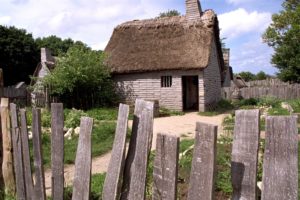 |
The Plimouth Plantation website has a great assortment of educational resources for kids, including an interactive investigation of the first Thanksgiving, a Thanksgiving virtual field trip, and a list of illustrated historical essays for kids, among them “Who Were the Pilgrims?.” “Who Were the Wampanoag?,” “Thanksgiving,” and “What’s For Dinner?” |
| From Scholastic, The First Thanksgiving has information, virtual field trips, activities, historical letters, videos and slide shows, interviews with Plimouth Plantation Pilgrim and native American re-enactors, and lesson plans (for grades K-2, 3-5, and 6-8). |
